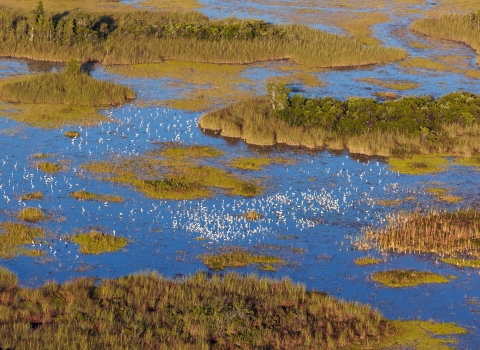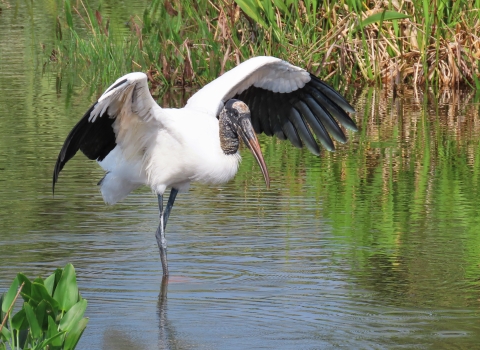Q: What action is the Service taking?
A: The Service has determined that the U.S. breeding population of wood storks no longer faces the imminent threat of extinction and is proposing to remove the species from the Endangered Species Act.
Q: What is a wood stork?
A: Wood storks are the only true species of stork that breeds in the United States. This prehistoric-looking wading bird stands four feet tall on long legs with a white feathered body and iridescent green and black flight feathers and tail. Its gray-colored pebbly bald head with little black eyes and a large heavy bill has earned it the endearment of “Old Flinthead.” Ungainly as it may appear on land, this bird gracefully soars on a five-foot wingspan with head and legs outstretched, traveling as far as 80 miles to find food to feed their chicks. They often disperse hundreds of miles and sometimes across multiple states after the breeding season.
A wood stork moves slowly through the water stalking its prey by feeling with its large thick bill ajar. When it touches a fish, the bill snaps shut in 25 milliseconds, a hunting method known as tactile foraging. They breed after the rainy season when wetland water levels are decreasing and concentrate their prey, which coincides with the time their nestlings are growing at a maximum rate. A pair of nesting wood storks and their young need a lot of food: more than 400 pounds of fish during the breeding season, which lasts about 120 days. They nest in colonies, building their nests in trees or on islands surrounded by water, where alligators deter raccoons and other predators from consuming their eggs and young.
It was projected that the U.S. breeding population of wood storks was headed toward extinction by the turn of the 21st century when they were listed under the ESA in 1984. Today, the wood stork breeding population has doubled, the number of nesting colonies has tripled, and the breeding range has expanded from south Florida north into Georgia, South Carolina, and North Carolina. Today’s overall range now includes Mississippi and North Carolina, and, during the warmer months, wood storks are commonly found in the coastal plains of Mississippi, Alabama, Florida, Georgia, South Carolina, and North Carolina.
Q: Why is the Service proposing to remove the wood stork from the protection of the ESA?
A: The best available scientific and commercial data indicate that since listing in 1984, the breeding population has increased, and the overall range and breeding range have expanded significantly. While habitat loss and the effects of climate change climate change
Climate change includes both global warming driven by human-induced emissions of greenhouse gases and the resulting large-scale shifts in weather patterns. Though there have been previous periods of climatic change, since the mid-20th century humans have had an unprecedented impact on Earth's climate system and caused change on a global scale.
Learn more about climate change may still pose a threat to the wood stork in the future, those threats no longer place the species in danger of extinction because of its resilience and ecological ability to respond to changing environmental conditions.
Impacts on wood storks and other wetland-dependent avian species in the greater Everglades have been well documented over the past 50 years. Today with the focus on Everglades’ restoration, wood storks and other wetland-dependent species are responding positively.
Q: What did the Service consider in reaching its decision to remove ESA protections for the wood stork?
A: The ESA requires the Service to determine whether a species is endangered or threatened based on one or more of the five following factors:
- The present or threatened destruction, modification, or curtailment of its habitat or range.
- Overutilization for commercial, recreational, scientific, or educational purposes.
- Disease or predation.
- The inadequacy of existing regulatory mechanisms.
- Other natural or man-made factors affecting its continued existence.
The Service conducted a thorough status review based on these factors using the best scientific and commercial information available by the Code of Federal Regulations: 50 CFR 424.14(c) and Section 4(a)(1) of the ESA.
Q: What is the range for the U.S. breeding population of wood storks?
A: When the US breeding population of wood storks was listed under the ESA in 1984, its range included Florida, Georgia, South Carolina, and Alabama with breeding concentrated in Central and South Florida and included 29 nesting colonies.
Since listing in 1984, the number of wood stork nesting colonies has more than tripled with the most recent survey in 2021 documenting 99 nesting colonies spread from Florida north into Georgia, South Carolina, and North Carolina. Today’s overall range now includes Mississippi and North Carolina and during the warmer months of the year, wood storks are commonly found in the wetlands of the coastal plains of the Southeast U.S. in Mississippi, Alabama, Florida, Georgia, South Carolina, and North Carolina.
Q: What is the current population status of the U.S. breeding population of wood storks?
A: When it was listed in 1984, the population had declined from 20,000 nesting pairs to an estimated 4,000 to 5,000 pairs. Since then, the breeding population has continually increased to a total nesting pair population of more than 10,000 since 2016. In 2020 the surveys were incomplete because of COVID protocols. The 2021 nesting season produced a record count in South Carolina of 3,493, and the second highest count on record since listing in 1984 with a total of 12,342 nests/nesting pairs. The highest on record was in 2009 with 13,711.
Q: Did the U.S. breeding population of wood storks meet the recovery plan criteria?
A: Recovery plans guide listed species recovery with measurable criteria to evaluate progress. They are not regulatory documents. Recovery can be achieved without all the criteria in a recovery plan being fully met.
The recovery plan for the wood stork outlines the following three criteria that, if met, could indicate recovery of the species that may no longer warrant listing under the ESA:
- A 5-year average of 10,000 nesting pairs (which constitutes 50% of the historical population). This criterion has been met since 2016. This criterion implies that wood storks must exhibit a positive population growth trend to reach a breeding population of 10,000 nesting pairs. The long-term trend shows an increase in annual nest counts and the current trend during the past 10 years of 5-year averages shows an increase in nest counts of 344 nests per year.
Five-year moving averages of nest counts in the U.S. Breeding Population (2010-2019).
Year | 2010 | 2011 | 2012 | 2013 | 2014 | 2015 | 2016 | 2017 | 2018 | 2019 |
5yr avg. | 8,742 | 8,094 | 8,877 | 9,681 | 9,226 | 9,941 | 10,171 | 10,650 | 11,012 | 10,582 |
2. A 5-year average of at least 1.5 chicks per nest per year in each of the four breeding regions. This has been met or exceeded in each region except for in South Breeding Florida since 2018 or earlier.
Five-year moving average of annual regional productivity (2014-2019)
Region\Year | 2014 | 2015 | 2016 | 2017 | 2018 | 2019 |
Northeast | 1.6 | 1.7 | 1.7 | 1.9 | 2.0 | 1.9 |
Northwest | 1.3 | 1.3 | 1.0 | 1.2 | 1.5 | 1.7 |
Central | 1.4 | 1.5 | 1.5 | 1.7 | 1.7 | 1.8 |
South | 0.7 | 0.8 | 0.7 | 1.0 | 1.0 | 0.8 |
3. As a subset of the 10,000 nesting pairs calculated over 5 years, a minimum of 2,500 successful nesting pairs must occur in the South Breeding Region (the Everglades and Big Cypress systems). This criterion was recently achieved in 2013 and 2018 but has not been achieved every year consistently, or in the most recent year for which data were available in 2019.
Five-year moving averages of nest counts in the South Breeding Region (2010-2019).
Year | 2010 | 2011 | 2012 | 2013 | 2014 | 2015 | 2016 | 2017 | 2018 | 2019 |
5yr avg. | 2,135 | 1,991 | 2,116 | 2,650 | 1,975 | 1,994 | 1,840 | 2,293 | 2,689 | 2,238 |
When wood stork recovery criteria were originally defined, the focus was on breeding success in the South Breeding Region because of its historical importance as the center and core of the breeding population. Since then, the wood stork population has continued to grow, expanding its breeding range to include new regions and using new habitat types. The species uses coastal salt marshes of Georgia and South Carolina for breeding, which provides year-round consistent foraging, with prey concentrations being tidally dependent and less impacted by the factors that dictate prey availability in the inland freshwater wetlands.
They are using human-made wetlands for colony sites and foraging throughout the breeding range. The expansion of the wood stork’s breeding range, novel exploitation of other wetland habitat types to support breeding, and a dispersed population breeding in multiple regions and states, indicates the species is now less reliant upon any one wetland ecosystem for viability.
We conclude that productivity and breeding pair numbers are sufficient for wood stork viability and continue to support a stable or growing population across the species’ entire range. While productivity and nesting pairs are stable but slightly under targets set originally for the South Breeding Region, the targets for these metrics have been met or exceeded in all other breeding regions. The wood stork is much less dependent on the South Breeding Region than it was historically. Thus, although Criteria 2 and 3 have not been fully realized in the manner specifically identified in the recovery plan, the criteria intend to ensure that productivity and abundance are sufficient for the long-term viability of the U.S. breeding population of the wood stork has been satisfied.
There is still work to be done to further restore the wood stork’s full breeding potential in the Everglades and Big Cypress systems. The Comprehensive Everglades Restoration Plan enacted by Congress in 2000 remains among the highest national conservation priorities for the Service.
Delisting the wood stork would not change the Service’s focus on the Everglades restoration as CERP will continue to focus on restoration that can support robust wood stork breeding within the Everglades and Big Cypress ecosystems. This is measured by the three CERP goals of 1,500 to 3,000 nesting pairs annually (a target already being met), breeding initiation no later than January, and that 70% of nesting occurs in the coastal zone (a target that has shown some improvement). We further note that these goals include the restoration of wood stork nesting within the Big Cypress Corkscrew Swamp system.
Q: Would the delisting mean the Service will shift focus away from the U.S. breeding population of wood storks’ historic range in South Florida and/or the Comprehensive Everglades Restoration Project?
A: No. The restoration of the Everglades and Big Cypress systems remains among the highest national conservation priorities for the Service. The Service recognizes the conservation work that the Comprehensive Everglades Restoration Plan generated for wood stork recovery and the positive impact that collaborative conservation efforts over the last two decades have had on the wood stork breeding population and other wading bird species. We will continue to address the threats associated with habitat loss, the protection, and restoration of natural wetlands through partnerships, the focused management of public lands, and the restoration of the Everglades.
Q: Did the Service’s decision to propose to delist the U.S. breeding population of wood storks include considerations of projected climate change and sea level rise?
A: Yes, the Service considered projections related to climate change, including sea level rise. Climate change effects of sea level rise, rainfall pattern changes, and seasonal temperature changes could affect the distribution, amount, and quality of wood stork habitat, nesting success, and the range of the species. Habitat does not appear to be a limiting factor, as there is an abundance of suitable freshwater wetland and salt marsh salt marsh
Salt marshes are found in tidal areas near the coast, where freshwater mixes with saltwater.
Learn more about salt marsh habitat available that is not yet being used by the expanding wood stork population.
The southeastern United States has nearly 48 million acres of wetlands and this is by far more than any other region of the country and accounts for over 43% of the nation’s wetlands. Most of that is in the wood stork’s range within the coastal plains of Mississippi, Alabama, Florida Georgia, South Carolina, and North Carolina. While sea level rise will render some currently occupied coastal habitats unusable for wood storks, there will also be gains in new tidal wetlands from sea level rise, and there will likely be an adequate amount of additional unoccupied suitable habitats available for use even under various scenarios of future sea level rise.
We now know that there is flexibility for wood storks regarding where or whether to nest, with individuals readily responding to environmental conditions and optimizing breeding and foraging habitat within and among colony sites, breeding regions, and breeding years. This behavioral flexibility suggests that the species will have the ability to adjust to changing habitat conditions in the future, just as they do now and have historically. Thus, wood storks are expected to be able to tolerate future shifts in suitable habitats caused by climate change.
Q: What will happen if the wood stork is delisted?
A: The ESA would require the Service to implement a post-delisting monitoring plan for the wood stork for a minimum of five years after delisting to ensure that it remains stable.
If delisted, wood storks will continue to be protected by the Migratory Bird Treaty Act, and the protection and restoration of the wetland habitats they depend upon will continue under the Clean Water Act. The Comprehensive Everglades Restoration Plan will focus on restoration that can support robust wood stork breeding within the Everglades and Big Cypress ecosystems.
Q: What is contributing to the U.S. breeding population of wood storks’ recovery?
A: Conservation efforts and regulatory mechanisms. The long–term survival and recovery of the wood stork requires a mosaic of wetland habitats for breeding, foraging, and roosting scattered throughout their range during varying climatic and seasonal conditions. Current management actions that address foraging and breeding habitats include maintaining and protecting existing wetlands, creating new wetland habitats, and restoring previously impacted habitats. Details of conservation efforts can be found in the SSA report (Service 2021, Chapter 5.1.4), but are summarized below:
Lands with natural and manmade wetlands are being targeted for acquisition for conservation through federal, state, and private acquisition programs, which will contribute to wood stork recovery.
Large–scale federal-state ecosystem restoration initiatives of wetland ecosystems throughout the southeastern United States, including:
Alabama – Eufaula NWR, Choctaw NWR, Demopolis WMA, and Upper Delta WMA
Florida - Everglades, Picayune Strand, Southern Corkscrew Watershed, Kissimmee River, Upper St. Johns River Basin,
Everglades Headwaters, Tampa Bay Estuary, Lake Apopka
Georgia -- Altamaha River Watershed, Lower Savannah River Watershed
Mississippi – Sam Hamilton Noxubee NWR, Tennessee-Tombigbee Waterway, Pascagoula River, and Pearl River
North Carolina – Alligator Creek, Carolina Beach State Park, Indian Creek, Lower Black River, Lower Cape Fear River
Merrick Creek, Moze Heritage Site, and Navassa Waterfront Park
South Carolina – ACE (Ashepoo/Combahee/Edisto Rivers) Basin Focus Area.
- Smaller-scale, localized restoration projects on individual public, private, industrial, and Department of Defense properties within the range of the U.S. distinct population segment of wood storks improve wood stork habitat through the National Coastal Wetlands Program, Wetland Reserves Program, Partners for Wildlife, Stewardship Incentive Program, North American Waterfowl Management Plan, and North American Wetlands Conservation Act.
Colony sites have been restored, resulting in wood stork recolonization.
Suitable foraging wetlands are being created within diked “impoundments,” restoration of impacted wetlands, and creation of shallow short hydro–period wetlands.
Tidal impoundments on former rice fields in South Carolina and Georgia are being managed to provide winter habitat for waterfowl and foraging for wood storks year around and, by staggering drawdowns, concentrated prey is being made available throughout the breeding and post–breeding seasons.
Wetland parks created from wastewater treatment flow and other wetland features are increasing within the southeastern United States and are being used by wood storks as foraging and breeding habitats.
Wetlands negatively impacted by encroaching woody plants are being restored by removing the plants and making them available for wood storks for colonies and foraging sites.
Colonies occurring on state and federal lands (Service refuges, National Park Service, Department of Defense, National Aeronautics and Space Administration) are afforded some protection from development and large–scale habitat disturbance through state and federal regulations, and on private lands through conservation partnerships and landowner stewardship.
To minimize the potential loss of colony sites, partnerships have been developed through conservation easements, wetland restoration projects, and other conservation means.
Q: How are public comments considered in making the Service’s final decision?
A: The first step is publishing a proposed rule in the Federal Register and seeking review and comment by other federal agencies, state biologists, and the public, as well as the advice of independent species experts. After analyzing the comments, we respond to them and announce our final decision in the Federal Register, either completing the final rule or withdrawing the action and maintaining the current species’ status.
Q: What information is the Service requesting?
A: We request comments or information from other governmental agencies, Native American tribes, the scientific community, industry, the public, or any other interested parties concerning this proposed rule.
We particularly seek comments concerning:
- Reasons we should or should not remove the wood stork from the endangered species list.
- New information on the history and status, range, distribution, and population size of the wood stork.
- New information on the known and potential threats to the wood stork.
- New information regarding the life history, ecology, and habitat-use of the wood stork.
- Current or planned activities within the geographic and habitat range of the wood stork that may have adverse or beneficial impacts on the species.
- Information about post-delisting monitoring of the wood stork.
Q: How can the public comment on this proposal?
A: We will accept comments received or postmarked on or before April 17, 2023. Comments submitted electronically using the Federal eRulemaking Portal must be received by 11:59 p.m. Eastern Time on the closing date. We must receive requests for public hearings, in writing, at the address shown in FOR FURTHER INFORMATION CONTACT by April 3, 2023.
You may submit comments on this proposed rule by one of the following methods:
1. Electronically: Go to the federal eRulemaking Portal: http://www.regulations.gov. In the Search box, enter FWS-R4-ES-2022-0099, which is the docket number for this rulemaking. Then, in the Search panel on the left side of the screen, under the Document Type heading, click on the Proposed Rules link to locate this document.
2. By hard copy: Submit by U.S. mail or hand-delivery to: Public Comments Processing, Attn: FWS-R4-ES-2022-0099; U.S. Fish and Wildlife Service, MS: BPHC, 5275 Leesburg Pike, Falls Church, VA 22041–3803.
Please send comments only by the methods described above. Comments will be posted on http://www.regulations.gov. The proposed rule, species status assessment, 5-year review, and post-delisting monitoring plan are available at http://www.regulations.gov under Docket No. FWS-R4-ES-2022-0099.
For further information contact Lourdes Mena, Florida Chief of Classification and Recovery, U.S. Fish and Wildlife Service, Florida Ecological Services Field Office, 7915 Baymeadows Way, Jacksonville, FL 32256-7517; telephone 904-731-3134. Persons who use a telecommunications device for the deaf (TDD) may call the Federal Relay Service at 800-877-8339.






